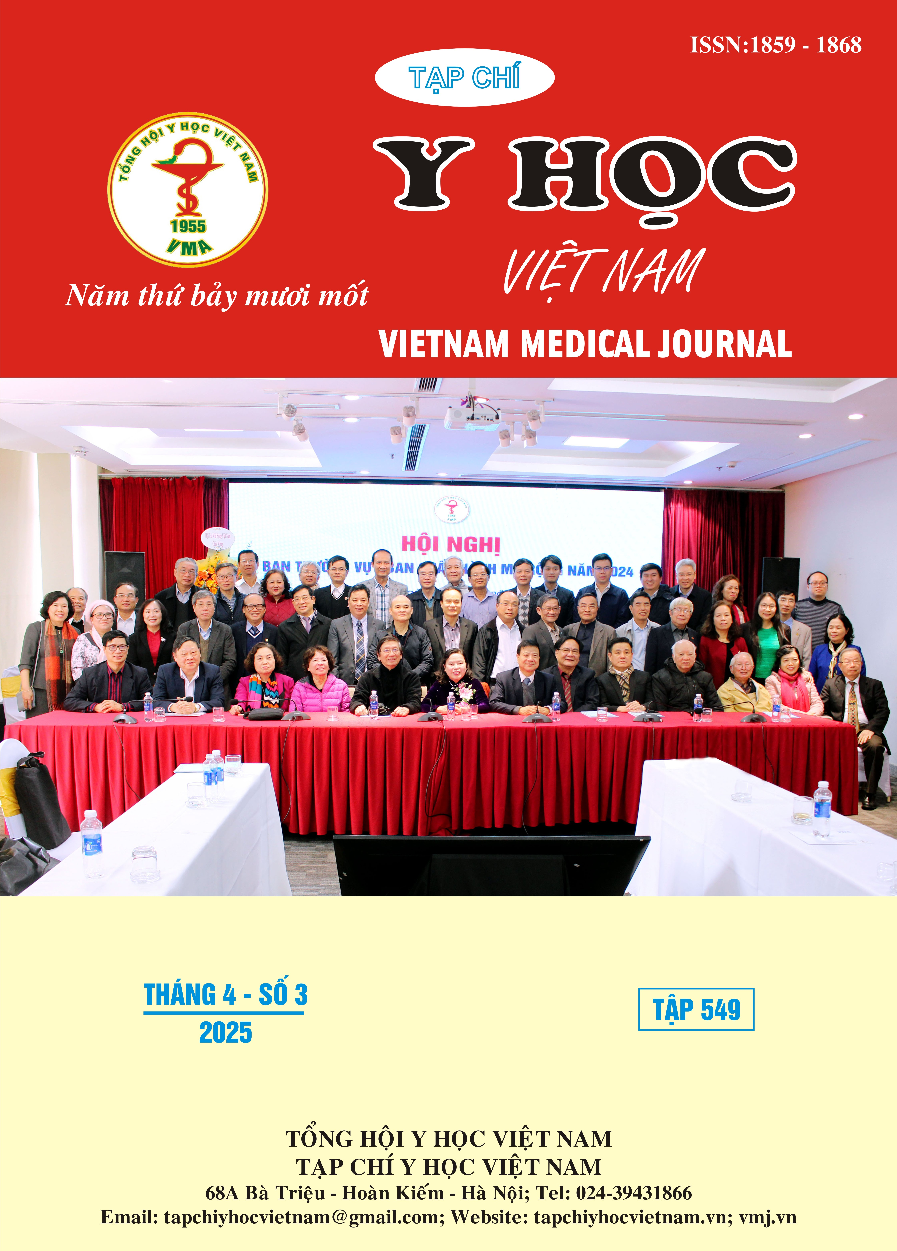EVALUATION OF THE EFFECTIVENESS OF ENDOSCOPIC ULTRASOUND IN THE DIAGNOSIS OF GASTRIC GIST AT K HOSPITAL
Main Article Content
Abstract
Background: This study aims to describe the clinical characteristics, endoscopic images, endoscopic ultrasound images, intervention methods, and histopathological results of submucosal tumors originating from the muscular layer of the stomach with sizes larger than 2 cm, and to evaluate the effectiveness, sensitivity, and specificity of endoscopic ultrasound in diagnosing gastric GIST tumors. Population and methods: A prospective cross-sectional study was conducted on 21 patients with gastric submucosal tumors detected through upper gastrointestinal endoscopy at K Hospital from November 2023 to December 2024. Patients who underwent endoscopy and were found to have gastric submucosal tumors with an indication for endoscopic ultrasound (EUS) were selected. Tumors originating from the muscular layer of the gastric wall that were diagnosed as GIST or gastric leiomyoma and had indications for biopsy or surgical intervention were included. Endoscopic images, EUS characteristics, and histopathological results were collected and incorporated into the study. Results: The most common age group for GIST tumors is over 50 years old. The incidence of GIST tumors in males and females is relatively equal at 1/1. Abdominal pain is the main reason patients seek medical attention (accounting for 80.9%). 71.4% of patients who come for examination with symptoms are diagnosed with GIST tumors. Similar to other submucosal tumors in the stomach, GIST tumors with smooth surfaces are predominant at 50%. Tumors with central depression account for 42.8%. Among 21 patients, 76.1% were diagnosed with GIST tumors, 19% with leiomyoma tumors. The average size of tumors was 32±11 mm (ranging from 21-52 mm), with 71.5% of GIST tumors measuring larger than 3 cm. Heterogeneous hypoechoic GIST tumors account for 73.3%, homogeneous ones account for 21.4%. Hypervascular (85.7%) and hypoechoic cysts (71.4%) are common characteristics of GIST tumors. The sensitivity, specificity, negative predictive value, positive predictive value, and diagnostic accuracy of endoscopic ultrasound in diagnosing gastric GIST tumors are: 85%, 66.7%, 66.6%, 87.5%, and 85.7%, respectively. Conclusion: EUS should be the primary diagnostic modality following endoscopy for submucosal tumors larger than 2cm in the stomach. EUS provides high diagnostic accuracy and differentiation capability between GIST and other muscular-origin tumors of the gastric wall
Article Details
Keywords
submucosal tumor, endoscopic ultrasound, GIST
References
2. Hedenbro JL, Ekelund M, Wetterberg P. Endoscopic diagnosis of sub- mucosal gastric lesions. The results after routine endoscopy. Surg En- dosc 1991;5:20-23.
3. Lim YJ, Son HJ, Lee JS, et al. Clinical course of subepithelial lesions detected on upper gastrointestinal endoscopy. World J Gastroenterol 2010;16:439-444.
4. Chak A. EUS in submucosal tumors. Gastrointest. Endosc. 2002; 56: S43–8.
5. Hwang JH, Saunders MD, Rulyak SJ, et al. A prospective study comparing endoscopy and EUS in the evaluation of GI subepithelial masses. Gastrointest Endosc 2005;62:202-8.
6. Kim KM, Kang DW, Moon WS, et al. Gastrointestinal Stromal Tumor Committee; Korean Gastrointestinal Pathology Study Group. Gastrointestinal stromal tumors in Koreans: İt›s incidence and the clinical, pathologic and immunohistochemical findings. J Korean Med Sci. 2005;20:977–84.
7. Miettinen M, Majidi M, Lasota J. Pathology and diagnostic criteria of gastrointestinal stromal tumors (GISTs): A review. Eur J Cancer. 2002;38(Suppl 5):S39–51
8. Vaicekauskas R, Urbonienė J, Stanaitis J, Valantinas J. Evaluation of Upper Endoscopic and Endoscopic Ultrasound Features in the Differential Diagnosis of Gastrointestinal Stromal Tumors and Leiomyomas in the Upper Gastrointestinal Tract. Visc Med. 2020 Aug;36(4):318-324
9. Nishida T, Kumano S, Sugiura T et al. Multidetector CT of high-risk patients with occult gastrointestinal stromal tumors. AJR Am. J. Roentgenol. 2003; 180: 185–9.
10. Palazzo L, Landi B, Cellier C, Cuillerier E, Roseau G, Barbier JP. Endosonographic features predictive of benign and malignant gastrointestinal stromal cell tumours. Gut. 2000;46:88-92.


